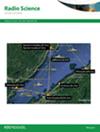Wavelet Analysis of Differential TEC Measurements Obtained Using LOFAR
IF 1.6
4区 地球科学
Q3 ASTRONOMY & ASTROPHYSICS
引用次数: 0
Abstract
Radio interferometers used to make astronomical observations, such as the LOw Frequency ARray (LOFAR), experience distortions imposed upon the received signal due to the ionosphere as well as those from instrumental errors. Calibration using a well‐characterized radio source can be used to mitigate these effects and produce more accurate images of astronomical sources, and the calibration process provides measurements of ionospheric conditions over a wide range of length scales. The basic ionospheric measurement this provides is differential Total Electron Content (TEC, the integral of electron density along the line of sight). Differential TEC measurements made using LOFAR have a precision of <1 mTECu and therefore enable investigation of ionospheric disturbances which may be undetectable to many other methods. We demonstrate an approach to identify ionospheric waves from these data using a wavelet transform and a simple plane wave model. The noise spectra are robustly characterized to provide uncertainty estimates for the fitted parameters. An example is shown in which this method identifies a wave with an amplitude an order of magnitude below those reported using Global Navigation Systems Satellite TEC measurements. Artificially generated data are used to test the accuracy of the method and establish the range of wavelengths which can be detected using this method with LOFAR data. This technique will enable the use of a large and mostly unexplored data set to study traveling ionospheric disturbances over Europe.利用 LOFAR 获取的 TEC 差分测量结果的小波分析
用于进行天文观测的无线电干涉仪,如低频雷达(LOFAR),会受到电离层以及仪器误差对接收信号造成的失真影响。使用特性良好的射电源进行校准可减轻这些影响,并生成更精确的天文源图像,校准过程可提供大范围长度尺度的电离层状况测量结果。它提供的基本电离层测量方法是差分电子总含量(TEC,电子密度沿视线方向的积分)。利用 LOFAR 进行的差分 TEC 测量精度小于 1 mTECu,因此能够调查许多其他方法可能无法检测到的电离层扰动。我们展示了一种利用小波变换和简单平面波模型从这些数据中识别电离层波的方法。对噪声频谱进行了稳健表征,以提供拟合参数的不确定性估计。举例说明了这种方法识别出的电离层波的振幅比全球导航系统卫星 TEC 测量报告的振幅低一个数量级。使用人工生成的数据来测试该方法的准确性,并确定使用该方法和 LOFAR 数据可以探测到的波长范围。这项技术将使人们能够利用大量大部分尚未开发的数据集来研究欧洲上空的行进电离层扰动。
本文章由计算机程序翻译,如有差异,请以英文原文为准。
求助全文
约1分钟内获得全文
求助全文
来源期刊

Radio Science
工程技术-地球化学与地球物理
CiteScore
3.30
自引率
12.50%
发文量
112
审稿时长
1 months
期刊介绍:
Radio Science (RDS) publishes original scientific contributions on radio-frequency electromagnetic-propagation and its applications. Contributions covering measurement, modelling, prediction and forecasting techniques pertinent to fields and waves - including antennas, signals and systems, the terrestrial and space environment and radio propagation problems in radio astronomy - are welcome. Contributions may address propagation through, interaction with, and remote sensing of structures, geophysical media, plasmas, and materials, as well as the application of radio frequency electromagnetic techniques to remote sensing of the Earth and other bodies in the solar system.
 求助内容:
求助内容: 应助结果提醒方式:
应助结果提醒方式:


